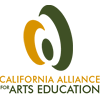Reviewing Sample Policies
An arts education policy is a statement of belief and a clear declaration that the arts are core curriculum and of intrinsic value. Once the team has established a shared understanding of the components required for a quality arts education program, it may be helpful to review a few sample policies. At this point, many excellent policies have been written, so it is not necessary to re-invent the wheel. It is important, however, for the Community Arts Team to carefully work through the process and decide which approach fits the district. The way the policy formatted must adhere to district guidelines. Some districts prefer a narrative format, others bulleted lists.
Click here [Word Doc: 43KB] to access one document containing two examples of district arts policies, as well as a resolution supporting arts education by the California School Boards Association [.doc]. These are provided in Microsoft Word format to facilitate adaptation for your own use.
Stage 3 Focused Conversation | Reviewing Sample District Arts Policies
Objectives
- To carefully consider all statements in the policy to discern if it is sending a comprehensive and clear statement of belief in the value of arts education programs for all students K-12 in our district.
- To feel excited that the Board of Education will have a clear statement of the value of the arts and that it will become part of our shared vision.
Context
- A group of team members have selected a few sample policies for us to review. Since we now have a good understanding of the district’s existing arts education programs, we can develop a clear statement of beliefs about the value of and need for arts education in our district K-12. Let’s take a look at the samples and see where our ideas and beliefs are reflected.
- First we’ll silently review the sample policies. Then we’ll discuss what we notice and our reactions, and how the sample policies might inform our own district arts policy.
- Facilitator: Use the questions below to guide the conversation. It is not necessary to ask every question, but it is recommended that they be asked in the sequence presented.
Questions
| Objective Level: | Name one topic that these sample policies cover? What is one thing you notice about how the policies are formatted? How would you describe the way the information is communicated? |
| Reflective Level: | What was your first reaction to these policies? Where are you anxious as to whether our Board would adopt it? Where are you confident? How might these policies be helpful to furthering our goals? How might they be unhelpful? |
| Interpretive Level: | What is the importance of adopting a policy? What kinds of changes would you suggest in the samples you reviewed? What other commitments or beliefs do we need to consider? What questions does this raise for you? |
| Decisional Level: | What do you recommend we include in our policy? What parts would you leave out? How will we communicate our policy to the greater community? What actions will we need to take to move the policy towards adoption? |
Closing
Thank you for taking the time to review these policies. I believe we can adopt some of this language, add our own and craft a clear message about the value of arts education in our district. This is an important step in forging a strong relationship with the Board and creating a shared vision for arts education in our district and the greater community.







